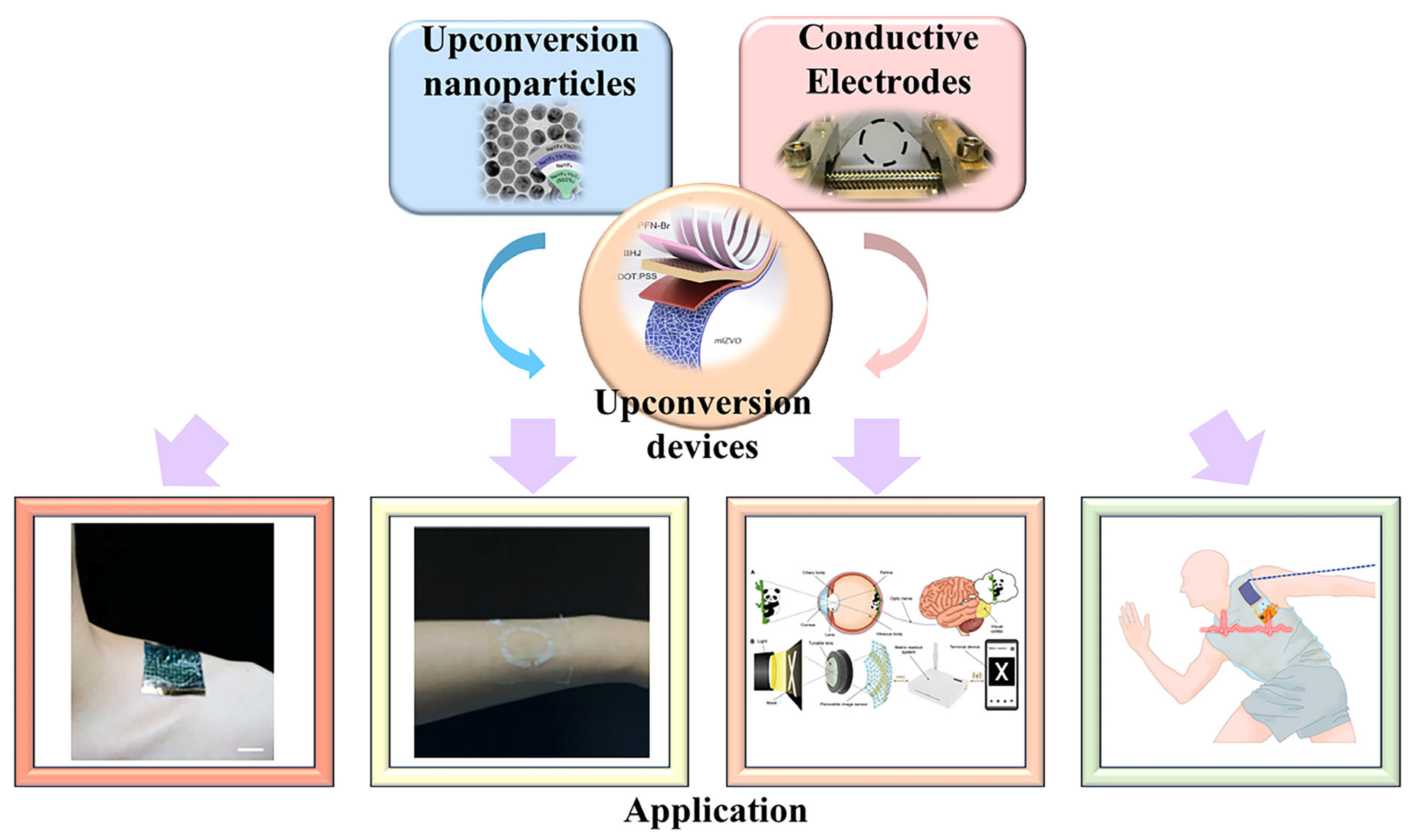The Transition of Luminescent Materials and Conductive Electrodes in Upconversion Devices to Flexible Architectures
Abstract
1. Introduction
2. Mechanisms of Upconversion Emission Devices in UCNPs
2.1. Excited State Absorption
2.2. Energy Transfer Upconversion
2.3. Triplet–Triplet Annihilation Upconversion
2.4. Energy Migration Upconversion
2.5. Photon Avalanche
3. Key Components of Flexible Upconversion
3.1. Upconversion Material Layer
3.2. Conductive Electrodes
4. Opportunities and Challenges for Flexible Upconversion Devices
5. Conclusions
Author Contributions
Funding
Institutional Review Board Statement
Informed Consent Statement
Data Availability Statement
Conflicts of Interest
References
- Dong, S.; Li, J.; Ma, T.; Zhang, M.; Zhu, L.; Gao, X.; Ma, M.; Yuan, W.; Wang, Z.; Liu, F.; et al. Ternary Compensation Enables High-sensitive Efficient Upconversion Device for NIR Visualization. Adv. Mater. 2024, 37, e2412678. [Google Scholar] [CrossRef] [PubMed]
- Han, X.; Han, J.; He, M.; Han, C.; Guo, L.; Yu, H.; Gou, J.; Wang, J. Achieving over 30% Photon-to-Photon Efficiency with Tandem OLED Structures in Organic Upconversion Devices. J. Mater. Chem. C 2025, 13, 11814–11822. [Google Scholar] [CrossRef]
- Geng, S.; Li, H.; Lv, Z.; Zhai, Y.; Tian, B.; Luo, Y.; Zhou, Y.; Han, S. Challenges and Opportunities of Upconversion Nanoparticles for Emerging NIR Optoelectronic Devices. Adv. Mater. 2025, e2419678. [Google Scholar] [CrossRef] [PubMed]
- Kwon, T.H.; Kim, H.B.; Kwak, D.G.; Hahm, D.; Yoo, S.; Kim, B.; Bae, W.K.; Kang, M.S. Quantum Dot-Based Three-Stack Tandem Near-Infrared-to-Visible Optoelectric Upconversion Devices. ACS Nano 2024, 18, 21957–21965. [Google Scholar] [CrossRef] [PubMed]
- Chen, Y.; Zheng, Y.; Wang, J.; Zhao, X.; Liu, G.; Lin, Y.; Yang, Y.; Wang, L.; Tang, Z.; Wang, Y.; et al. Ultranarrow-Bandgap Small-Molecule Acceptor Enables Sensitive SWIR Detection and Dynamic Upconversion Imaging. Sci. Adv. 2024, 10, eadm9631. [Google Scholar] [CrossRef]
- Rao, T.; Hao, Q.; Mu, G.; Qin, T.; Tan, Y.; Zhao, P.; Kong, D.; Chen, M.; Tang, X. Large-Scale Fabrication of CMOS-Compatible Silicon-OLED Heterojunctions Enabled Infrared Upconverters. APL Photonics 2023, 8, 036106. [Google Scholar] [CrossRef]
- Chu, C.; Wu, P.; Chen, J.; Tsou, N.; Lin, Y.; Lo, Y.; Li, S.; Chang, C.; Chen, B.; Tsai, C.; et al. Flexible Optogenetic Transducer Device for Remote Neuron Modulation Using Highly Upconversion-Efficient Dendrite-Like Gold Inverse Opaline Structure. Adv. Healthc. Mater. 2022, 11, 2101310. [Google Scholar] [CrossRef]
- Ji, Y.; Hu, X.; Ren, M.; Luo, X.; Lu, Y.; Chen, Q.; Li, N.; Sui, X. Infrared-to-Visible Upconversion Imagers: Recent Advances and Future Trends. IEEE Open J. Immersive Disp. 2024, 1, 107–118. [Google Scholar]
- Liu, C.; Quan, H.; Shi, Y.; Chen, H.; Dong, H.; Wang, J.; Tao, Y.; Chen, C.; Wang, J. Highly Flexible Honeycomb-Structured Flexible Transparent Conductive Electrodes by Inkjet Printing for Light-Emitting Devices. J. Mater. Chem. C 2025, 13, 11198–11206. [Google Scholar] [CrossRef]
- Cao, F.; Wu, Q.; Zhang, S.; Yu, W.; Kong, L.; Yang, Y.; Zhang, J.; Wang, S.; Yang, X. Surface- and Spatial-Regulated Cd-Free Quantum Dots for Efficient, Mechanically Stable, and Full-Color Flexible Light-Emitting Diodes. Adv. Mater. 2025, 37, 2420575. [Google Scholar] [CrossRef]
- Park, J.Y.; Shin, J.H.; Hong, I.P.; Nam, S.; Han, S.H.; Choi, S.S. Dynamic Bendable Display with Sound Integration Using Asymmetric Strain Control of Actuators with Flexible OLED. NPJ Flex. Electron. 2025, 9, 24. [Google Scholar] [CrossRef]
- Khabir, Z.; Guller, A.E.; Rozova, V.S.; Liang, L.; Lai, Y.-J.; Goldys, E.M.; Hu, H.; Vickery, K.; Zvyagin, A.V. Tracing Upconversion Nanoparticle Penetration in Human Skin. Colloids Surf. B Biointerfaces 2019, 184, 110480. [Google Scholar] [CrossRef]
- Xu, Z.; Zhang, C.; Wang, F.; Yu, J.; Yang, G.; Surmenev, R.A.; Li, Z.; Ding, B. Smart Textiles for Personalized Sports and Healthcare. Nano-Micro Lett. 2025, 17, 232. [Google Scholar] [CrossRef] [PubMed]
- Xiang, H.; Hu, Z.; Billot, L.; Aigouy, L.; Zhang, W.; McCulloch, I.; Chen, Z. Heavy-Metal-Free Flexible Hybrid Polymer-Nanocrystal Photodetectors Sensitive to 1.5 Μm Wavelength. ACS Appl. Mater. Interfaces 2019, 11, 42571–42579. [Google Scholar] [CrossRef] [PubMed]
- Strassel, K.; Ramanandan, S.P.; Abdolhosseinzadeh, S.; Diethelm, M.; Nüesch, F.; Hany, R. Solution-Processed Organic Optical Upconversion Device. ACS Appl. Mater. Interfaces 2019, 11, 23428–23435. [Google Scholar] [CrossRef]
- Li, J.; Shen, Y.; Liu, Y.; Shi, F.; Niu, T.; Zhao, K. Stable High Performance Flexible Photodetector Based on Upconversion Nanoparticles/Perovskite Microarrays Composite. ACS Appl. Mater. Interfaces 2017, 9, 19176–19183. [Google Scholar] [CrossRef] [PubMed]
- Balhara, A.; Rohilla, R.; Dutta, B.; Prakash, J.; Samui, S.; Gupta, S.K. Flexible and Water-Resistant Y3Al5O12:Er3+/Yb3+ Upconversion Nanoparticles-Based Luminescent Cellulose Paper for Anti-Counterfeiting and VOCs Detection. Adv. Opt. Mater. 2025, 13, 2500898. [Google Scholar] [CrossRef]
- Chen, L.; Chen, S.; Uma, K.; Chiang, C.; Xie, J.; Tseng, Z.; Liu, S. High-Leakage-Resistance and Low-Turn-On-Voltage Upconversion Devices Based on Perovskite Quantum Dots. Adv. Funct. Mater. 2024, 34, 2309589. [Google Scholar] [CrossRef]
- Wang, X.; Hu, Y.; Chen, L.; Jiang, H.; Wang, Z.; Lei, Y. Performance Improvement of an Upconversion Device through Optimized Carrier Injection Balance. Opt. Lett. 2025, 50, 1361. [Google Scholar] [CrossRef]
- Yan, Y.; He, J.; Wang, M.; Yang, L.; Jiang, Y. Microsphere Photonic Superlens for a Highly Emissive Flexible Upconversion-Nanoparticle-Embedded Film. ACS Appl. Mater. Interfaces 2022, 14, 24636–24647. [Google Scholar] [CrossRef]
- Mu, G.; Rao, T.; Zhang, S.; Wen, C.; Chen, M.; Hao, Q.; Tang, X. Ultrasensitive Colloidal Quantum-Dot Upconverters for Extended Short-Wave Infrared. ACS Appl. Mater. Interfaces 2022, 14, 45553–45561. [Google Scholar] [CrossRef]
- Hu, P.; Xu, H.; Pan, Y.; Sang, X.; Liu, R. Upconversion Particle-Assisted NIR Polymerization Enables Microdomain Gradient Photopolymerization at Inter-Particulate Length Scale. Nat. Commun. 2023, 14, 3653. [Google Scholar] [CrossRef]
- Hagstrom, A.L.; Lee, H.-L.; Lee, M.-S.; Choe, H.-S.; Jung, J.; Park, B.-G.; Han, W.-S.; Ko, J.-S.; Kim, J.-H.; Kim, J.-H. Flexible and Micropatternable Triplet–Triplet Annihilation Upconversion Thin Films for Photonic Device Integration and Anticounterfeiting Applications. ACS Appl. Mater. Interfaces 2018, 10, 8985–8992. [Google Scholar] [CrossRef]
- Ji, H.; Luo, Z.; Yang, X.; Jin, X.; Zhao, T.; Duan, P. Chiral Dual-Annihilator Model for Controllable Photon Upconversion and Multi-Dimensional Optical Modulation. Nat. Commun. 2025, 16, 4952. [Google Scholar] [CrossRef]
- Ieuji, R.; Goushi, K.; Adachi, C. Triplet–Triplet Upconversion Enhanced by Spin–Orbit Coupling in Organic Light-Emitting Diodes. Nat. Commun. 2019, 10, 5283. [Google Scholar] [CrossRef]
- Zhang, W.; Huang, X.; Liu, W.; Gao, Z.; Zhong, L.; Qin, Y.; Li, B.; Li, J. Semiconductor Plasmon Enhanced Upconversion toward a Flexible Temperature Sensor. ACS Appl. Mater. Interfaces 2023, 15, 4469–4476. [Google Scholar] [CrossRef] [PubMed]
- Nirmal, K.A.; Dongale, T.D.; Khot, A.C.; Yao, C.; Kim, N.; Kim, T.G. Ultra-Transparent and Multifunctional IZVO Mesh Electrodes for Next-Generation Flexible Optoelectronics. Nano-Micro Lett. 2025, 17, 12. [Google Scholar] [CrossRef] [PubMed]
- He, Z.; Sun, B.; Lu, H.; Sun, X.; Xu, Z.; Liang, Y.; Lu, Q.; Yu, Y.; Hu, K.; Poddar, S.; et al. Focus-Tunable Real-Time Imaging System Based on Ultrathin Perovskite Curved Image Sensor with Hierarchical Mesh Design. Sci. Adv. 2025, 11, 7826. [Google Scholar] [CrossRef] [PubMed]
- Saifi, S.; Xiao, X.; Cheng, S.; Guo, H.; Zhang, J.; Müller-Buschbaum, P.; Zhou, G.; Xu, X.; Cheng, H.-M. An Ultraflexible Energy Harvesting-Storage System for Wearable Applications. Nat. Commun. 2024, 15, 6546. [Google Scholar] [CrossRef]
- Wang, Y.; Deng, R.; Xie, X.; Huang, L.; Liu, X. Nonlinear Spectral and Lifetime Management in Upconversion Nanoparticles by Controlling Energy Distribution. Nanoscale 2016, 8, 6666–6673. [Google Scholar] [CrossRef]
- Hu, X.; Meng, X.; Zhang, L.; Zhang, Y.; Cai, Z.; Huang, Z.; Su, M.; Wang, Y.; Li, M.; Li, F.; et al. A Mechanically Robust Conducting Polymer Network Electrode for Efficient Flexible Perovskite Solar Cells. Joule 2019, 3, 2205–2218. [Google Scholar] [CrossRef]
- Yoon, H.; Jeong, S.; Lee, B.; Hong, Y. A Site-Selective Integration Strategy for Microdevices on Conformable Substrates. Nat. Electron. 2024, 7, 383–395. [Google Scholar] [CrossRef]
- Guillemot, L.; Loiko, P.; Doualan, J.-L.; Braud, A.; Camy, P. Excited-State Absorption in Thulium-Doped Materials in the near-Infrared. Opt. Express 2022, 30, 31669. [Google Scholar] [CrossRef]
- Trindade, C.M.; Alves, R.T.; Rego-Filho, F.D.A.M.G.; Gouveia-Neto, A.S. White Light Generation via Sequential Stepwise Absorption and Energy-Transfer Frequency Upconversion in Tm3+/Er3+-Codoped Glass. J. Solid State Chem. 2017, 255, 13–16. [Google Scholar] [CrossRef]
- Tyazhev, A.; Loiko, P.; Guillemot, L.; Kouta, A.; Solé, R.M.; Mateos, X.; Aguiló, M.; Díaz, F.; Dupont, H.; Georges, P.; et al. Excited-State Absorption and Upconversion Pumping of Tm3+-Doped Potassium Lutetium Double Tungstate. Opt. Express 2023, 31, 14808. [Google Scholar] [CrossRef] [PubMed]
- Ma, Y.; Li, Y.; Feng, J.; Zhang, K. Influence of Energy-Transfer Upconversion and Excited-State Absorption on a High Power Nd:YVO4 Laser at 134 Μm. Opt. Express 2018, 26, 12106. [Google Scholar] [CrossRef] [PubMed]
- Charbonnière, L.J.; Nonat, A.M.; Knighton, R.C.; Godec, L. Upconverting Photons at the Molecular Scale with Lanthanide Complexes. Chem. Sci. 2024, 15, 3048–3059. [Google Scholar] [CrossRef]
- Chen, J.; Zhao, J.X. Upconversion Nanomaterials: Synthesis, Mechanism, and Applications in Sensing. Sensors 2012, 12, 2414–2435. [Google Scholar] [CrossRef]
- Zhang, Y.; Du, W.; Liu, X. Photophysics and Its Application in Photon Upconversion. Nanoscale 2024, 16, 2747–2764. [Google Scholar] [CrossRef]
- Yin, H.-J.; Xiao, Z.-G.; Feng, Y.; Yao, C.-J. Recent Progress in Photonic Upconversion Materials for Organic Lanthanide Complexes. Materials 2023, 16, 5642. [Google Scholar] [CrossRef]
- Zhang, W.; Jia, H.; Ye, H.; Dai, T.; Yin, X.; He, J.; Chen, R.; Wang, Y.; Pang, X. Facile Fabrication of Transparent and Upconversion Photoluminescent Nanofiber Mats with Tunable Optical Properties. ACS Omega 2018, 3, 8220–8225. [Google Scholar] [CrossRef] [PubMed]
- Ngo, T.T.; Cabello-Olmo, E.; Arroyo, E.; Becerro, A.I.; Ocaña, M.; Lozano, G.; Míguez, H. Highly Versatile Upconverting Oxyfluoride-Based Nanophosphor Films. ACS Appl. Mater. Interfaces 2021, 13, 30051–30060. [Google Scholar] [CrossRef]
- Park, B.J.; Hong, A.-R.; Park, S.; Kyung, K.-U.; Lee, K.; Seong Jang, H. Flexible Transparent Displays Based on Core/Shell Upconversion Nanophosphor-Incorporated Polymer Waveguides. Sci. Rep. 2017, 7, srep45659. [Google Scholar] [CrossRef] [PubMed]
- Zhao, J.; Ji, S.; Guo, H. Triplet–Triplet Annihilation Based Upconversion: From Triplet Sensitizers and Triplet Acceptors to Upconversion Quantum Yields. RSC Adv. 2011, 1, 937. [Google Scholar] [CrossRef]
- Zeng, L.; Huang, L.; Han, J.; Han, G. Enhancing Triplet–Triplet Annihilation Upconversion: From Molecular Design to Present Applications. Acc. Chem. Res. 2022, 55, 2604–2615. [Google Scholar] [CrossRef]
- Lin, W.; Li, J.; Feng, H.; Qi, F.; Huang, L. Recent Advances in Triplet–Triplet Annihilation Upconversion for Bioimaging and Biosensing. J. Anal. Test. 2023, 7, 327–344. [Google Scholar] [CrossRef]
- Yu, T.; Liu, Y.; Zeng, Y.; Chen, J.; Yang, G.; Li, Y. Triplet–Triplet Annihilation Upconversion for Photocatalytic Hydrogen Evolution. Chem. A Eur. J. 2019, 25, 16270–16276. [Google Scholar] [CrossRef]
- Klimezak, M.; Chaud, J.; Brion, A.; Bolze, F.; Frisch, B.; Heurtault, B.; Kichler, A.; Specht, A. Triplet-Triplet Annihilation Upconversion-Based Photolysis: Applications in Photopharmacology. Adv. Healthc. Mater. 2024, 13, e2400354. [Google Scholar] [CrossRef]
- Jin, J.; Yu, T.; Chen, J.; Hu, R.; Yang, G.; Zeng, Y.; Li, Y. Recent Advances of Triplet–Triplet Annihilation Upconversion in Photochemical Transformations. Curr. Opin. Green Sustain. Chem. 2023, 43, 100841. [Google Scholar] [CrossRef]
- Guo, S.; Tsang, M.-K.; Lo, W.-S.; Hao, J.; Wong, W.-T. 808 Nm Excited Energy Migration Upconversion Nanoparticles Driven by a Nd3+–Trinity System with Color-Tunability and Superior Luminescence Properties. Nanoscale 2018, 10, 2790–2803. [Google Scholar] [CrossRef]
- Wang, X.; Yan, L.; Liu, S.; Zhang, P.; Huang, R.; Zhou, B. Enhancing Energy Migration Upconversion through a Migratory Interlayer in the Core–Shell–Shell Nanostructure towards Latent Fingerprinting. Nanoscale 2020, 12, 18807–18814. [Google Scholar] [CrossRef] [PubMed]
- Liu, Y.; Pan, G.; Gao, H.; Zhang, H.; Ao, T.; Gao, W.; Mao, Y. Single Band Red Emission of Er3+ Ions Heavily Doped Upconversion Nanoparticles Realized by Active-Core/Active-Shell Structure. Ceram. Int. 2021, 47, 18824–18830. [Google Scholar] [CrossRef]
- Chu, Z.; Tian, T.; Tao, Z.; Yang, J.; Chen, B.; Chen, H.; Wang, W.; Yin, P.; Xia, X.; Wang, H.; et al. Upconversion nanoparticles@AgBiS2 Core-Shell Nanoparticles with Cancer-Cell-Specific Cytotoxicity for Combined Photothermal and Photodynamic Therapy of Cancers. Bioact. Mater. 2022, 17, 71–80. [Google Scholar] [CrossRef] [PubMed]
- Huang, J.; Wei, G.; Wei, H.; Zhou, B. Controlling Photon Avalanche Upconversion in Nanoparticles toward Frontier Applications. ACS Appl. Opt. Mater. 2024, 2, 1841–1853. [Google Scholar] [CrossRef]
- Szalkowski, M.; Kotulska, A.; Dudek, M.; Korczak, Z.; Majak, M.; Marciniak, L.; Misiak, M.; Prorok, K.; Skripka, A.; Schuck, P.J.; et al. Advances in the Photon Avalanche Luminescence of Inorganic Lanthanide-Doped Nanomaterials. Chem. Soc. Rev. 2025, 54, 983–1026. [Google Scholar] [CrossRef]
- Bednarkiewicz, A.; Chan, E.M.; Kotulska, A.; Marciniak, L.; Prorok, K. Photon Avalanche in Lanthanide Doped Nanoparticles for Biomedical Applications: Super-Resolution Imaging. Nanoscale Horiz. 2019, 4, 881–889. [Google Scholar] [CrossRef]
- Le-Vu, T.-T.; Chang, J.-R.; Pham, V.-D.; Lin, J.-Y.; Kan, H.-C.; Kuo, S.-W.; Hsu, C.-C. Guided-Mode Resonance-Assisted Photon Avalanche Emission from Tm3+-Doped NaYF4 Upconverting Nanoparticles: Implications for Biosensing Applications. ACS Appl. Nano Mater. 2025, 8, 427–437. [Google Scholar] [CrossRef]
- Wang, C.; Wen, Z.; Pu, R.; Pan, B.; Wang, B.; Zheng, K.; Du, Y.; Zhan, Q. Tandem Photon Avalanches for Various Nanoscale Emitters with Optical Nonlinearity up to 41st-Order through Interfacial Energy Transfer. Adv. Mater. 2024, 36, e2307848. [Google Scholar] [CrossRef]
- Liu, C.; Wang, Z.; Wang, X.; Li, Z. Surface Modification of Hydrophobic NaYF4:Yb,Er Upconversion Nanophosphors and Their Applications for Immunoassay. Sci. China Chem. 2011, 54, 1292–1297. [Google Scholar] [CrossRef]
- Mai, H.-X.; Zhang, Y.-W.; Sun, L.-D.; Yan, C.-H. Size- and Phase-Controlled Synthesis of Monodisperse NaYF4:Yb,Er Nanocrystals from a Unique Delayed Nucleation Pathway Monitored with Upconversion Spectroscopy. J. Phys. Chem. C 2007, 111, 13730–13739. [Google Scholar] [CrossRef]
- Yi, G.S.; Chow, G.M. Synthesis of Hexagonal-Phase NaYF4:Yb,Er and NaYF4:Yb,Tm Nanocrystals with Efficient Up-Conversion Fluorescence. Adv. Funct. Mater. 2006, 16, 2324–2329. [Google Scholar] [CrossRef]
- Guller, A.E.; Nadort, A.; Generalova, A.N.; Khaydukov, E.V.; Nechaev, A.V.; Kornienko, I.A.; Petersen, E.V.; Liang, L.; Shekhter, A.B.; Qian, Y.; et al. Rational Surface Design of Upconversion Nanoparticles with Polyethylenimine Coating for Biomedical Applications: Better Safe than Brighter? ACS Biomater. Sci. Eng. 2018, 4, 3143–3153. [Google Scholar] [CrossRef] [PubMed]
- Liu, C.; Wang, H.; Li, X.; Chen, D. Monodisperse, Size-Tunable and Highly Efficient β-NaYF4:Yb,Er(Tm) up-Conversion Luminescent Nanospheres: Controllable Synthesis and Their Surface Modifications. J. Mater. Chem. 2009, 19, 3546. [Google Scholar] [CrossRef]
- Rafique, R.; Baek, S.H.; Park, C.Y.; Chang, S.-J.; Gul, A.R.; Ha, S.; Nguyen, T.P.; Oh, H.; Ham, S.; Arshad, M.; et al. Morphological Evolution of Upconversion Nanoparticles and Their Biomedical Signal Generation. Sci. Rep. 2018, 8, 17101. [Google Scholar] [CrossRef]
- Martinez, P.M.; Ishteev, A.; Fahimi, A.; Velten, J.; Jurewicz, I.; Dalton, A.B.; Collins, S.; Baughman, R.H.; Zakhidov, A.A. Silver Nanowires on Carbon Nanotube Aerogel Sheets for Flexible, Transparent Electrodes. ACS Appl. Mater. Interfaces 2019, 11, 32235–32243. [Google Scholar] [CrossRef] [PubMed]
- Choi, J.; Kim, S.Y. Multi-Shell Structured Upconversion Nanocarriers That Combine IDO Inhibitor-Induced Immunotherapy with NIR-Triggered Photodynamic Therapy for Deep Tumors. Biomater. Sci. 2023, 11, 4684–4699. [Google Scholar] [CrossRef]
- Abuçafy, M.P.; Ramin, B.B.S.; Graminha, A.E.; Santos, W.G.; Frem, R.C.G.; Netto, A.V.G.; Pereira, J.C.M.; Ribeiro, S.J.L. Core–Shell UCNP@MOF Nanoplatforms for Dual Stimuli-Responsive Doxorubicin Release. ACS Appl. Bio Mater. 2025, 8, 2954–2964. [Google Scholar] [CrossRef]
- Wen, S.; Zhou, J.; Schuck, P.J.; Suh, Y.D.; Schmidt, T.W.; Jin, D. Future and Challenges for Hybrid Upconversion Nanosystems. Nat. Photonics 2019, 13, 828–838. [Google Scholar] [CrossRef]
- Xie, S.; Ren, B.; Gong, G.; Zhang, D.; Chen, Y.; Xu, L.; Zhang, C.; Xu, J.; Zheng, J. Lanthanide-Doped Upconversion Nanoparticle-Cross-Linked Double-Network Hydrogels with Strong Bulk/Interfacial Toughness and Tunable Full-Color Fluorescence for Bioimaging and Biosensing. ACS Appl. Nano Mater. 2020, 3, 2774–2786. [Google Scholar] [CrossRef]
- Ghorpade, K.B.; Kumar, M.; Tiwari, S. A Review on Composites Based on Upconversion Nanoparticles and Graphene Oxide: Development and Theranostic Applications Centered at Solid Tumors. J. Mater. Sci. Mater. Eng. 2024, 19, 48. [Google Scholar] [CrossRef]
- Chen, G.; Qiu, H.; Prasad, P.N.; Chen, X. Upconversion Nanoparticles: Design, Nanochemistry, and Applications in Theranostics. Chem. Rev. 2014, 114, 5161–5214. [Google Scholar] [CrossRef]
- Zhang, J.; Du, J.; Jia, S.; Li, Y.; Ågren, H.; Prasad, P.N.; Chen, G. Recent Advances in Upconversion Nanoparticles for Therapeutics: From Fundamentals to Cutting-Edge Applications. Electron 2025, 3, e70012. [Google Scholar] [CrossRef]
- Wang, F.; Liu, X. Multicolor Tuning of Lanthanide-Doped Nanoparticles by Single Wavelength Excitation. Acc. Chem. Res. 2014, 47, 1378–1385. [Google Scholar] [CrossRef]
- Gai, S.; Li, C.; Yang, P.; Lin, J. Recent Progress in Rare Earth Micro/Nanocrystals: Soft Chemical Synthesis, Luminescent Properties, and Biomedical Applications. Chem. Rev. 2014, 114, 2343–2389. [Google Scholar] [CrossRef] [PubMed]
- Safdar, M.; Ghazy, A.; Lastusaari, M.; Karppinen, M. Lanthanide-Based Inorganic–Organic Hybrid Materials for Photon-Upconversion. J. Mater. Chem. C 2020, 8, 6946–6965. [Google Scholar] [CrossRef]
- Ansari, A.A.; Nazeeruddin, M.K.; Tavakoli, M.M. Organic-Inorganic Upconversion Nanoparticles Hybrid in Dye-Sensitized Solar Cells. Coord. Chem. Rev. 2021, 436, 213805. [Google Scholar] [CrossRef]
- Manurung, R.V.; Wu, C.T.; Roy, P.K.; Chattopadhyay, S. A Plasmon-Tuned ‘Gold Sandwich’ for Metal Enhanced Fluorescence in Silica Coated NaYF4:Yb,Er Upconversion Nanoparticles. RSC Adv. 2016, 6, 87088–87095. [Google Scholar] [CrossRef]
- Wu, Z.; Xing, X.; Sun, Y.; Liu, Y.; Wang, Y.; Li, S.; Wang, W. Flexible Transparent Electrode Based on Ag Nanowires: Ag Nanoparticles Co-Doped System for Organic Light-Emitting Diodes. Materials 2024, 17, 505. [Google Scholar] [CrossRef]
- Li, R.; Wang, Q.; Jiang, J.; Xiang, X.; Ye, P.; Wang, Y.; Qin, Y.; Chen, Y.; Lai, W.; Zhang, X. Highly Stable Silver Nanowire Plasmonic Electrodes for Flexible Polymer Light-Emitting Devices. ACS Appl. Mater. Interfaces 2024, 16, 31419–31427. [Google Scholar] [CrossRef]
- Dutta, A.; Sathiyan, K.; Sharon, D.; Borenstein, A. Laser Induced Incorporation of CNTs in Graphene Electrodes Improves Flexibility and Conductivity. FlatChem 2022, 33, 100378. [Google Scholar] [CrossRef]
- Teh, D.B.L.; Bansal, A.; Chai, C.; Toh, T.B.; Tucker, R.A.J.; Gammad, G.G.L.; Yeo, Y.; Lei, Z.; Zheng, X.; Yang, F.; et al. A Flexi-PEGDA Upconversion Implant for Wireless Brain Photodynamic Therapy. Adv. Mater. 2020, 32, 2001459. [Google Scholar] [CrossRef]
- Chen, X.; Zhang, X.; Zhao, Y. Metal–Organic Framework-Based Hybrids with Photon Upconversion. Chem. Soc. Rev. 2025, 54, 152–177. [Google Scholar] [CrossRef]
- Chen, B.; Wang, F. Combating Concentration Quenching in Upconversion Nanoparticles. Acc. Chem. Res. 2020, 53, 358–367. [Google Scholar] [CrossRef]
- Zhou, M.; Zou, X.; Liu, Y.; Wang, H.; Su, Q. Degradation of Upconverting Nanoparticles in Simulated Fluids Evaluated by Ratiometric Luminescence. New J. Chem. 2022, 46, 8752–8759. [Google Scholar] [CrossRef]
- Kuk, S.K.; Jang, J.; Han, H.J.; Lee, E.; Oh, H.; Kim, H.Y.; Jang, J.; Lee, K.T.; Lee, H.; Jung, Y.S.; et al. Siloxane-Encapsulated Upconversion Nanoparticle Hybrid Composite with Highly Stable Photoluminescence against Heat and Moisture. ACS Appl. Mater. Interfaces 2019, 11, 15952–15959. [Google Scholar] [CrossRef] [PubMed]
- Guo, J.; Zhou, B.; Yang, C.; Dai, Q.; Kong, L. Stretchable and Upconversion-Luminescent Polymeric Optical Sensor for Wearable Multifunctional Sensing. Opt. Lett. 2019, 44, 5747. [Google Scholar] [CrossRef] [PubMed]
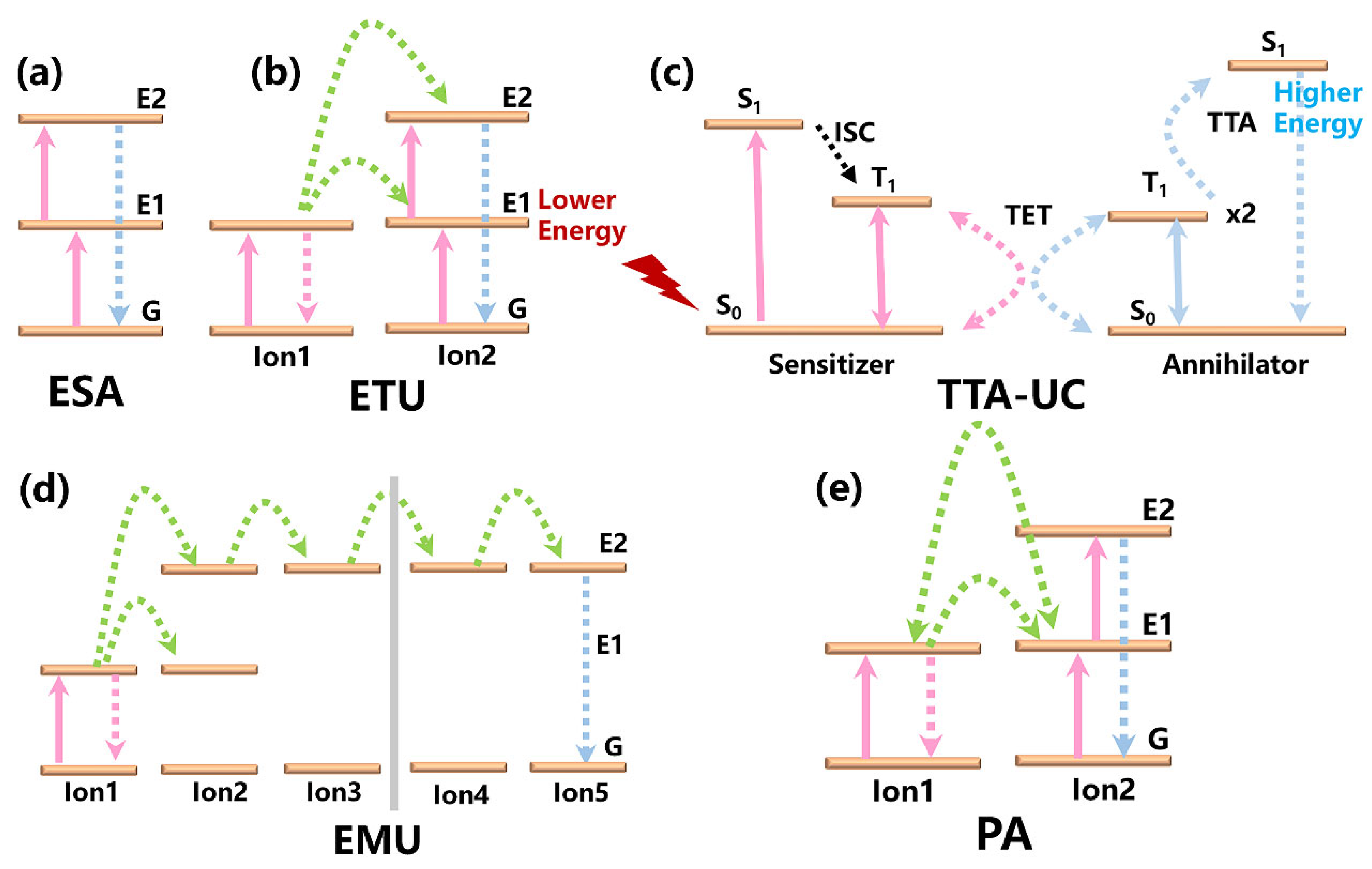
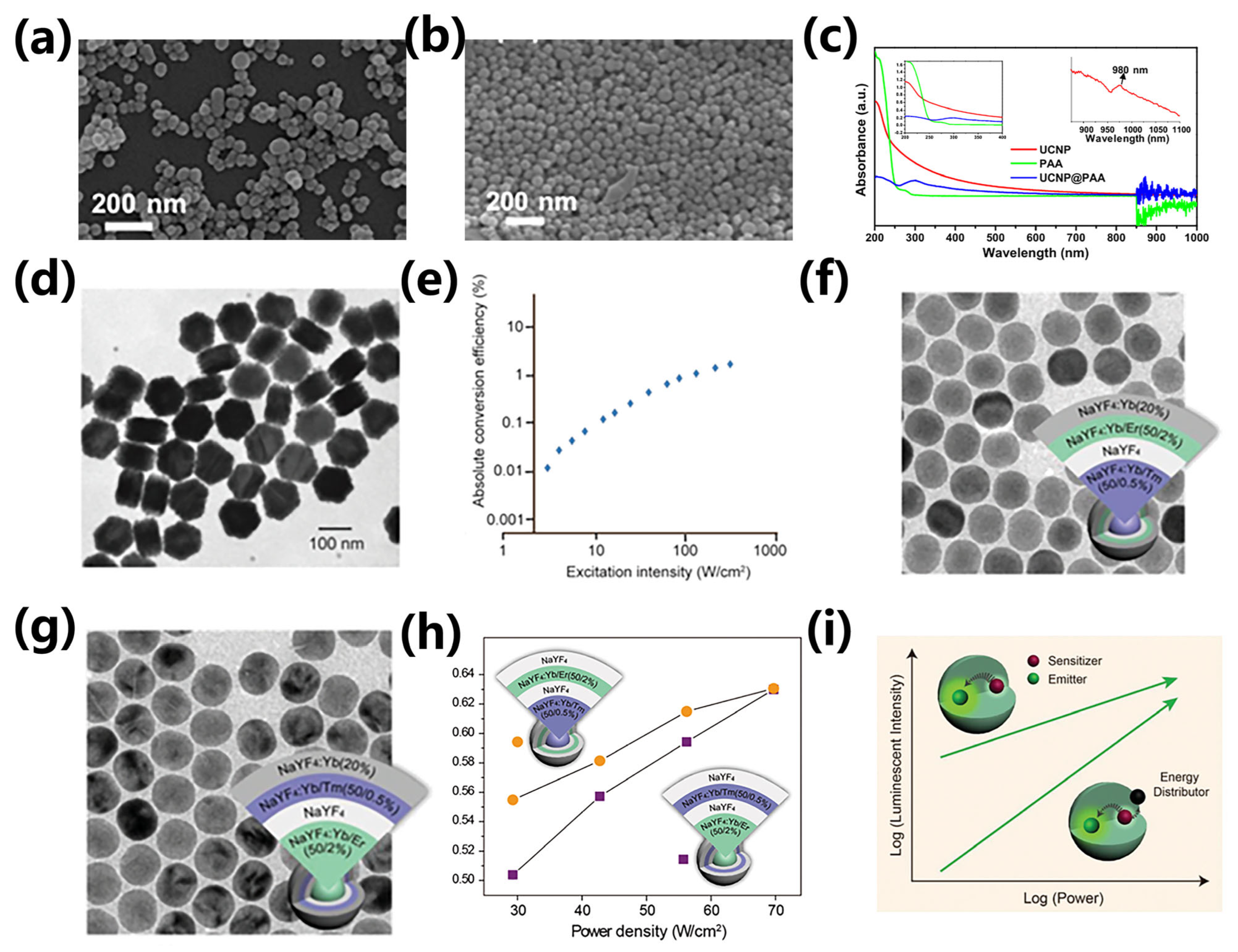
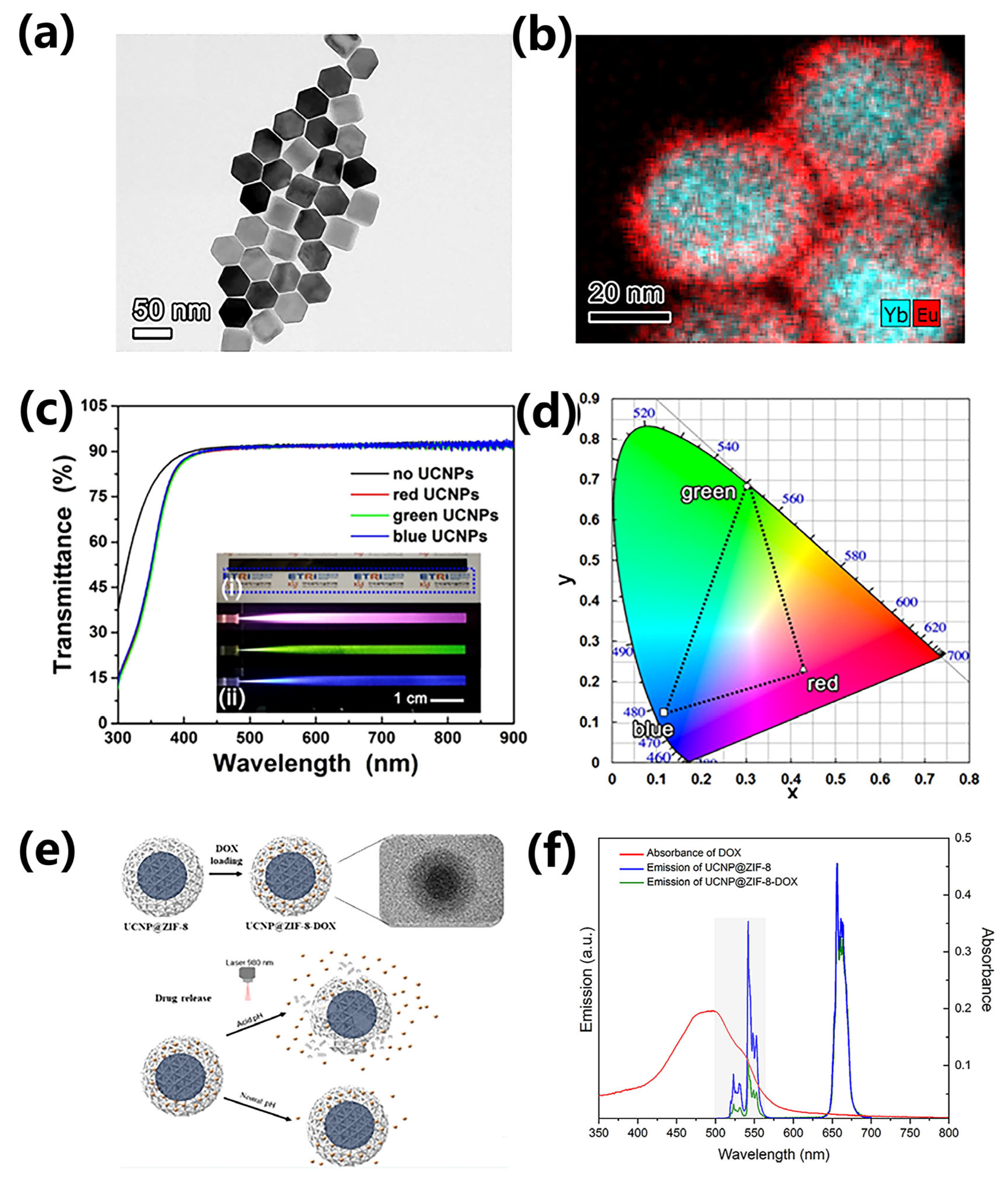
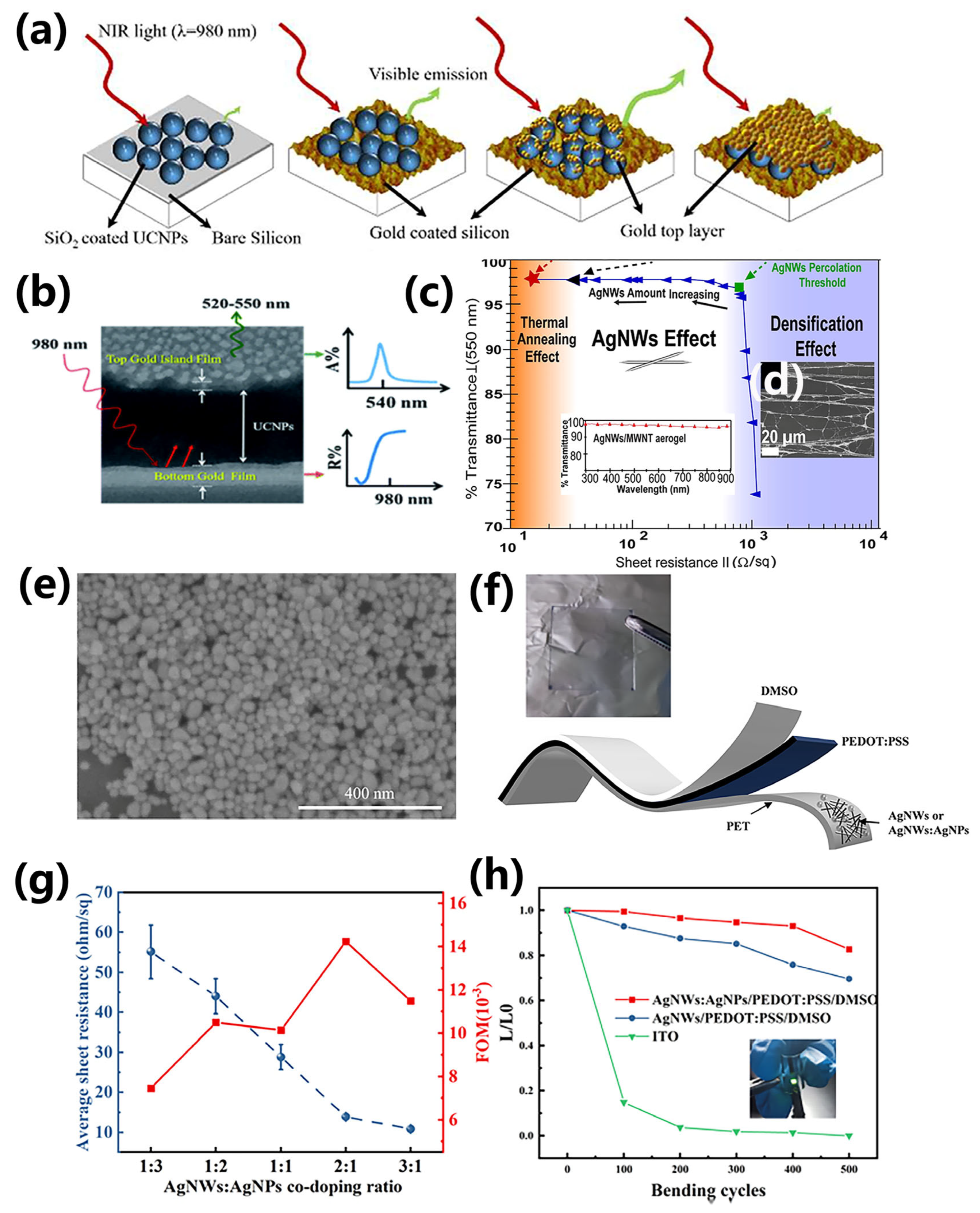
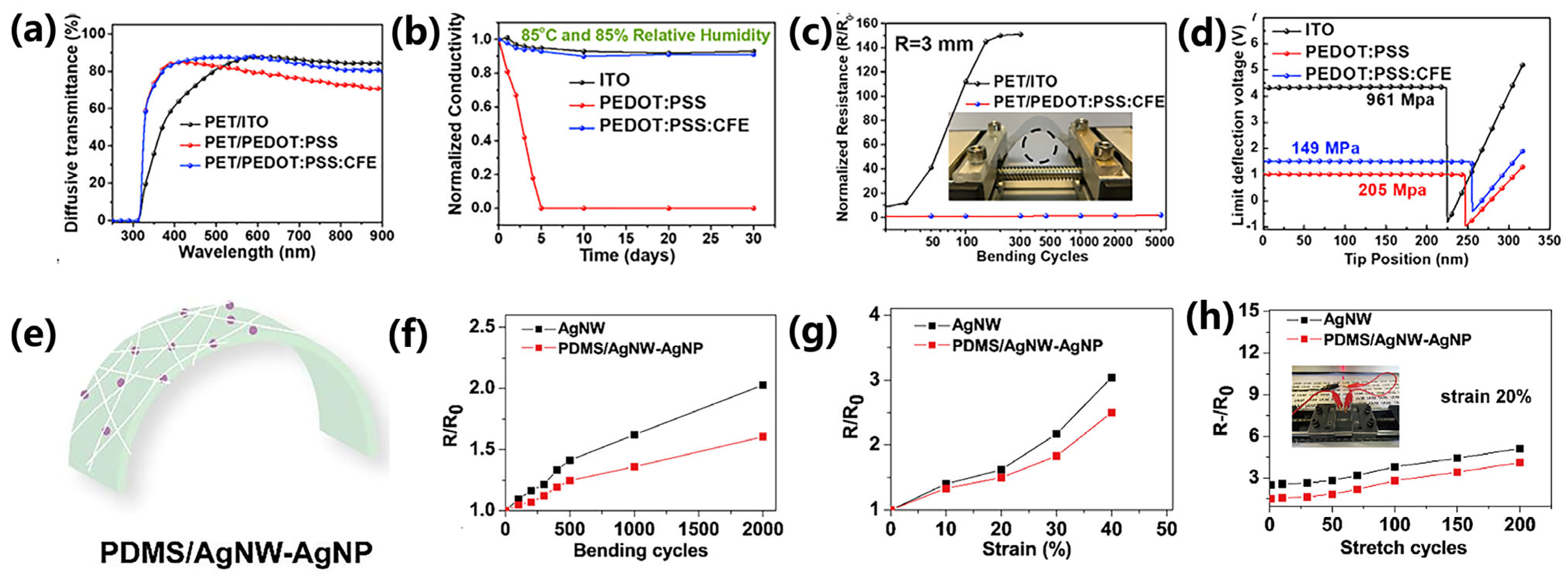
| Type | Advantages | Disadvantages | Performance in Flexible/Hybrid Systems | References |
|---|---|---|---|---|
| Absorber ions | Large absorption cross–sections; high energy transfer efficiency | Weak intrinsic emission; excessive doping may lead to concentration quenching | Ion spacing in flexible matrices can be optimized for energy transfer; non–radiative losses may lower overall efficiency | [71,72] |
| Emitter ion | Well–defined energy levels with tunable multicolor emission; high photostability | Narrow absorption necessitates sensitization; emission is sensitive to the host matrix | Emission in flexible/hybrid systems is enhanced by local field or ligand effects, but mechanical stress can reduce stability | [73,74] |
| Absorber ligands | Broaden absorption to enhance visible/NIR light harvesting; energy levels tunable via molecular design | Energy transfer efficiency is lower than inorganic absorbers; environmental stability is limited | Enables efficient energy transfer in flexible/hybrid matrices, but stability and mechanical durability are limited | [75] |
| Emitter ligands | Improves dispersion, reduces quenching, and enables emission wavelength/quantum yield tuning | Organic ligands may degrade under bending or heat; interactions with matrices can induce defects | Improves optical homogeneity and interfacial stability in flexible/hybrid systems; molecular design is needed to balance flexibility and luminescence | [76] |
| Dimension | Laser rGO/CNT [80] | AgNW–AgNP/L–His [79] | PEDOT:PSS:CFE [31] |
|---|---|---|---|
| Sheet Resistance | – | ~17.5 Ω/sq | ~24 Ω/sq |
| Conductivity | 13.51 × 103 S/m | – | >4000 S/cm |
| Bending test | 500 cycles | 100,000 cycles | 5000 cycles |
| Performance Retention after Bending | Capacitance: 98.2% | Luminance: 90% | PCE: 85–90% |
| Stability | 7 days | 30 days | >180 days |
Disclaimer/Publisher’s Note: The statements, opinions and data contained in all publications are solely those of the individual author(s) and contributor(s) and not of MDPI and/or the editor(s). MDPI and/or the editor(s) disclaim responsibility for any injury to people or property resulting from any ideas, methods, instructions or products referred to in the content. |
© 2025 by the authors. Licensee MDPI, Basel, Switzerland. This article is an open access article distributed under the terms and conditions of the Creative Commons Attribution (CC BY) license (https://creativecommons.org/licenses/by/4.0/).
Share and Cite
Chen, H.; Feng, W.; Qin, T. The Transition of Luminescent Materials and Conductive Electrodes in Upconversion Devices to Flexible Architectures. Photonics 2025, 12, 1075. https://doi.org/10.3390/photonics12111075
Chen H, Feng W, Qin T. The Transition of Luminescent Materials and Conductive Electrodes in Upconversion Devices to Flexible Architectures. Photonics. 2025; 12(11):1075. https://doi.org/10.3390/photonics12111075
Chicago/Turabian StyleChen, Huijuan, Weibo Feng, and Tianling Qin. 2025. "The Transition of Luminescent Materials and Conductive Electrodes in Upconversion Devices to Flexible Architectures" Photonics 12, no. 11: 1075. https://doi.org/10.3390/photonics12111075
APA StyleChen, H., Feng, W., & Qin, T. (2025). The Transition of Luminescent Materials and Conductive Electrodes in Upconversion Devices to Flexible Architectures. Photonics, 12(11), 1075. https://doi.org/10.3390/photonics12111075




